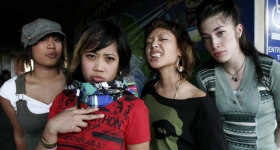A few weeks ago, Ly Tong was arrested for pepper-spraying Vietnamese singer Dam Vinh Hung at his Santa Clara concert. Of course, a YouTube clip captures the entire episode, recording the very moment Tong, decked out in his best female attire, douses the singer with the chemical. No, he was not frustrated by the shrill heartache requisite in every other Vietnamese song. Tong is an infamous Vietnamese American anticommunist activist. Dam Vinh Hung is a spiky-haired Vietnamese pop star who has been accused of being a communist puppet. Their incident highlights a persisting divisiveness that, 35 years after the Fall of Saigon, lingers among the Vietnamese people.
Tong’s arrest has summoned a series of questions: Is he merely a publicity-driven media spectacle as some suspect? With the appearance of protesters, including Congressman Anh “Joseph” Cao, demonstrating against Hung’s concert outside, does Tong represent the general sentiment of the Vietnamese American community? Who suggested to Tong that a white blazer and a giant hat would be a tasteful outfit? Most importantly, as Sonny Le writes in an editorial featured in the San Jose Mercury, “Why are we still fighting with each other over a war that brought about the loss of millions of Vietnamese lives from both north and south and the near-total destruction of the beautiful country that is Vietnam?”
The Vietnamese community that Le (and history) depicts is a community as delicate as it is complex. As Le says, it is a people marred by the “permanent damage that the [Vietnam War] has inflicted” and is separated by geography, language, ideology, and generation. In many ways, the Vietnamese community encompasses nuances and demographics beyond the communist and anticommunist, north and south, love and hate -- “employing political theatrics” and moving on.
The mid-ballad pepper spray tactic of Ly Tong is not an isolated act of politicking activism in the Vietnamese American community. In 2008, San Jose City Councilmember Madison Nguyen experienced fervent backlash and claims of communist ties after proposing that a Vietnamese commercial corridor be named “Saigon Business District” rather than the politically charged “Little Saigon.” In a situation rife in irony and complexity, a young Vietnamese American politician found herself at odds with the very constituency she sought to unite -- a constituency expressing pain and contempt of a current government by preserving the former name of its capital as “Little Saigons” across the world.
Similarly, to date, over 70 cities and municipalities have passed resolutions recognizing the symbolic yellow and red-striped Southern Vietnamese flag as the official “Vietnamese American Freedom and Heritage Flag.” The language of each passing resolution is ingrained with emotion, claiming the current “yellow star” emblem to “[represent] a source of anguish to countless people who fled.” Yet, every year more than 500,000 overseas Vietnamese or “Viet Kieu” return to Vietnam to visit, study, and live. Even more “Viet Kieu” send over 2 billion dollars annually in the form of remittances to the very country still bearing the yellow-starred flag. Tong himself, despite his hat, heel, and spray tactics, has been accused of merely wanting to capitalize on his American lifestyle with the intention of moving back to Vietnam -- showing that the activist, like the community, still grapples with an internal struggle born 35 years ago.
As the years pass and the Vietnamese community becomes more entrenched in contradiction, the question becomes more pronounced and still unanswered: “It has been [insert number of years]. Why are we still fighting?” To date, over three decades have passed since the Fall of Saigon, yet not time enough for the Vietnamese community to reach reconciliation and a resolution. In the United States, the schism doesn't necessarily end with first-generation Vietnamese Americans like Tong who directly experienced war. When Bay Area designer Ky Truong noticed a lack of Vietnamese representation in local t-shirt racks, he created the vibrant 3 Stripes Clothing line. Truong crafted a series of beautiful, if not inadvertently political, t-shirts (like his nostalgic "Forever Saigon" shirt) as the overriding voice of "2nd, 3rd, or even 4th generation [Vietnamese Americans]." Although this writer admits we are all indeed "Hot Like Sriracha," the Vietnamese complex lives on in the community's youth (and their t-shirts).
With the next generation taking up the flag, it's vital to get some clarity here. What exactly are we fighting for -- or against? Or can a shirt be just a shirt, an act of memory without an act of aggression?









Comments